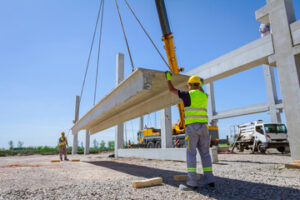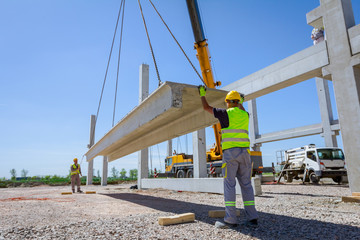Keeping an eye on the concrete around your home is important, as cracks can cause tripping hazards and damage the foundation. Concrete lifting is one way to fix these issues without repouring the slab.
Foam concrete lifting, also known as foam jacking or slab jacking, lifts sunken concrete by injecting a filler material beneath the surface. This process can eliminate tripping hazards and cosmetic eye sores for less than half the cost of replacing concrete. Visit https://concretecontractorcoloradosprings.com/ for more information.
Concrete is a tough, durable material that is used around the home to provide a stable foundation for walkways, patios, and driveways. Unfortunately, it can develop sinkholes over time if it is not properly maintained. These sinkholes can damage your driveway, sidewalk, or parking lot and cause tripping hazards for pedestrians. To fix the problem, you need to raise sunken concrete slabs by using a method called concrete lifting.
Concrete lifting can cost up to 75 percent less than a complete concrete replacement, and you can use the repaired area as soon as the process is completed. However, the price of concrete lifting depends on a few factors, such as the location and size of the sunken area. The type of filler used is also a factor in the cost of concrete lifting. There are two main types of fillers used in concrete lifting: stone slurry grout and foam. Foam concrete lifting is a more expensive option than stone slurry grout concrete lifting.
Stone slurry grout concrete lifting uses a mixture of pulverized limestone, agricultural lime, water, and Portland cement that is injected under the surface through holes. This slurry is pumped hydraulically to fill the void and lift the concrete. The slurry is usually pumped at low pressure, which allows trained professionals to control the amount of lift they achieve.
The advantage of this method is that it causes less damage to the surrounding soil and does not require excavation. However, the slurry must be backfilled with a dense material to support the load and prevent future cracking.
Mudjacking is an older method of concrete lifting that requires the drilling and injection of a thick mud-like material. This material is a mixture of sand, Portland cement, and water. It is injected through 1-5/8″ holes in the concrete and pumped under hydraulic pressure. This process is less costly than polylifting but does not offer the same level of precision.
The main reason why many homeowners choose concrete lifting is because it is much less invasive than tearing out and replacing the sunken concrete. This is because it does not require excavation or hauling away the old concrete, and you can continue to use your property while the work is being done. Additionally, concrete lifting can be completed in a shorter period of time than replacing the concrete.
Time
Concrete lifting, also known as mudjacking or slab jacking, involves injecting a liquid material underneath sunken concrete. This liquid quickly sets into a rigid foam, raising the concrete back to its original level. It is a much faster method than pouring new concrete, and it requires minimal disturbance to the surrounding landscape. This method is ideal for driveways, patios, and other outdoor concrete areas.
The first step is to drill a series of small holes in the concrete surface. The contractor then uses a pump to push the compound into these holes. The compound then fills any voids and creates backpressure, forcing the concrete back into its original position. This process usually takes about a day to complete. Once the concrete is lifted, the contractor patches the drill holes with regular concrete. It may not match the color of the rest of the concrete exactly, but it will blend in over time.
Many homeowners choose to use concrete lifting to repair sunken patios, sidewalks, and driveways. Uneven surfaces are a tripping hazard for people walking on them, and they can cause cars to drive off the road or into walls or fences. Concrete lifting can fix these issues safely and quickly, saving you money on repairs and preventing more expensive problems down the road.
When handling concrete, it is important to wear the right safety gear. Using gloves and long sleeves, as well as protective eyewear, can help prevent injuries. If concrete or cement gets on the skin, it should be washed off immediately. Injuries from touching wet concrete are typically minor, but more serious burns can occur if the skin is exposed to it for an extended period of time.
Mudjacking is a common way to lift sunken concrete, but it has some disadvantages. For one, it can take up to a week for the concrete to cure. Additionally, it can be costly and messy, and it is not good for the environment. Another issue is that it can damage the soil beneath the concrete, leading to further sinking. Instead, a more environmentally friendly method is concrete lifting, which uses polyurethane to lift sunken concrete.
Safety
Concrete is a tough material that can be dangerous to work with. There are many steps that must be taken to ensure that the lifting is done safely and correctly. This includes preparing the tools and equipment, assessing the situation, and careful handling of the slab. By following these tips, workers can ensure that their projects are completed quickly and safely.
When working with concrete, workers should always wear proper safety gear. This includes protective eyewear, gloves, and steel-toed boots. They should also use waterproof pads to protect their knees. Wet concrete can cause chemical burns if it comes into contact with the skin and mucous membranes. In addition, it can be very slippery. It is important to follow all the necessary safety precautions when lifting concrete to prevent injuries.
It is also important to keep the area around the sunken slab clear of obstructions. This will prevent tripping and falling over debris, which can be very dangerous. It is also a good idea to have a crane on site to help with the lifting process. This will save time and money, as well as reduce the risk of injury to the employees.
After the holes have been drilled, it is important to insert delivery ports into them. These ports will be used to pump the concrete lifting material into the voids under the sunken slab. These ports are essential for preventing spillage and other safety issues. It is also important to use the right amount of concrete lifting material. Overdoing it can damage the surface and lead to structural failure.
Concrete lifting is an effective way to repair sunken concrete. It is cheaper and faster than tearing out and replacing the concrete, and it can be done without damaging the surrounding landscape or property. Concrete lifting is also a green solution, as it avoids the need for landfills.
Before beginning a concrete project, it is crucial to understand the hazards and precautions involved. This will help the crew perform the job safely and efficiently. Some common construction hazards include unstable soil, contested property boundaries, changes in weather and terrain, a lack of safety protocols, and more. These hazards should be identified and addressed as they arise to ensure the success of the project.
Environment
Concrete lifting involves a lot of dust, which can be harmful to the environment. It is therefore important to make sure that you take the proper precautions. The best way to do this is by wearing protective clothing and using exhaust-ventilated tools. This will reduce the amount of dust in the air and prevent respiratory problems. You should also wear full-length pants and a long-sleeved shirt to protect your skin from concrete burns. It is also a good idea to use a respirator if you will be working with concrete or other dusty materials.
The process of concrete lifting involves drilling holes through the existing slab and injecting a filler material that raises (or jacks) the concrete back to its original position. It is a quicker, more cost-effective solution to traditional concrete replacement and is an excellent alternative to mudjacking.
While mudjacking uses a heavy, porous slurry that is pumped into the sunken concrete to create pressure and lift it, foam concrete lifting utilizes a lightweight liquid material that expands to fill the void underneath the slab. This allows for a more precise lift than is possible with mudjacking, and it can be completed in less time.
In addition, the injected liquid material is more environmentally friendly than traditional mudjacking. The foam is made of an eco-friendly, man-made material that does not require any new cement production and is safer for the environment than traditional mud. It also requires far fewer diesel-powered vehicles to perform the repairs, which means less pollution for your home.
In addition, the process of concrete lifting can also be used as a preventative measure, preventing future issues by filling voids before they cause settling or collapsible soil. This is an inexpensive option that can save homeowners thousands of dollars compared to the cost of replacing their concrete. It also offers an excellent return on investment. Concrete lifting is a great choice for any homeowner concerned about their environmental footprint.
